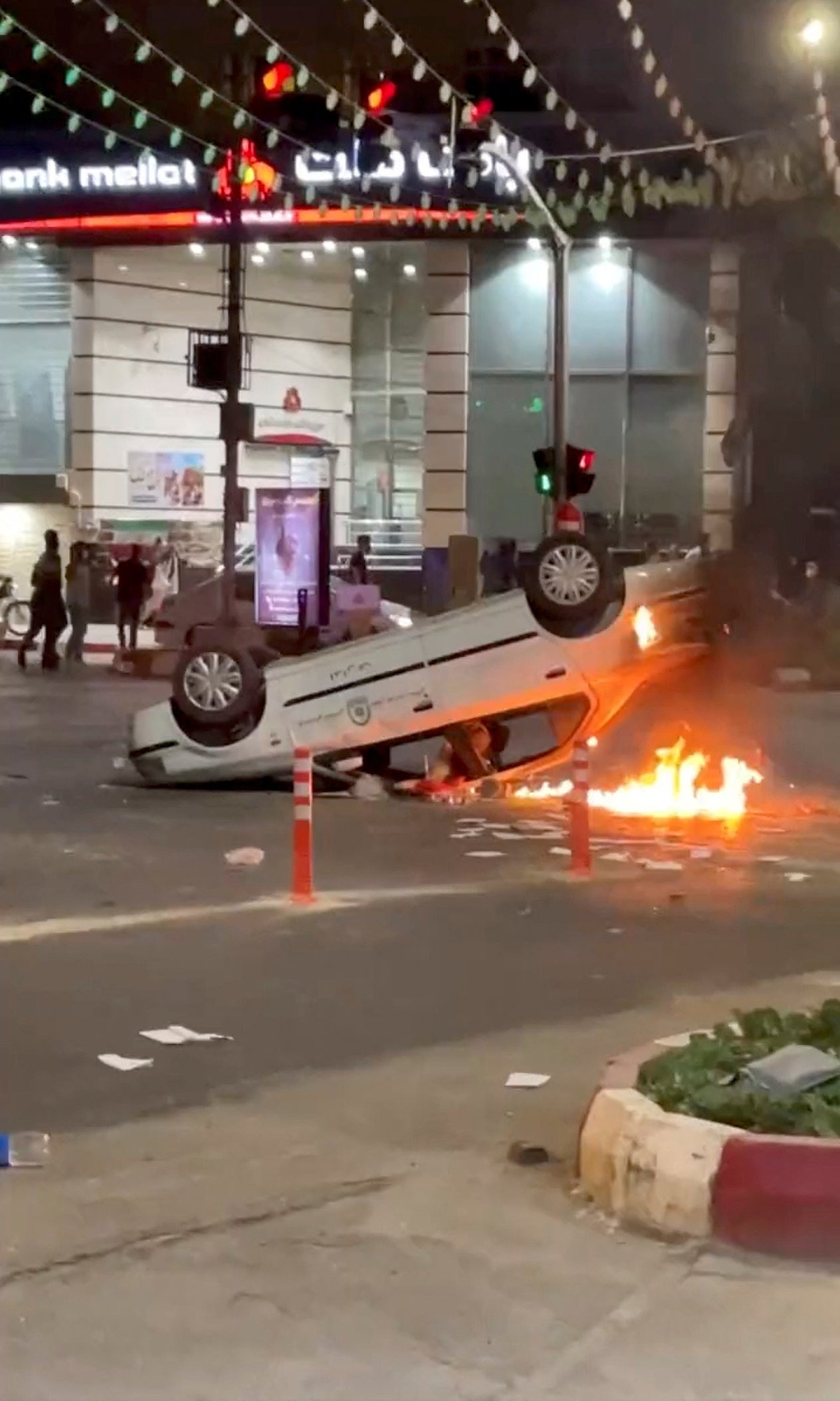Iranians rage against the regime as watching world weighs response
As protests rattle Iran, world struggles to formulate a response, if any
Your support helps us to tell the story
From reproductive rights to climate change to Big Tech, The Independent is on the ground when the story is developing. Whether it's investigating the financials of Elon Musk's pro-Trump PAC or producing our latest documentary, 'The A Word', which shines a light on the American women fighting for reproductive rights, we know how important it is to parse out the facts from the messaging.
At such a critical moment in US history, we need reporters on the ground. Your donation allows us to keep sending journalists to speak to both sides of the story.
The Independent is trusted by Americans across the entire political spectrum. And unlike many other quality news outlets, we choose not to lock Americans out of our reporting and analysis with paywalls. We believe quality journalism should be available to everyone, paid for by those who can afford it.
Your support makes all the difference.They are some of the most dramatic anti-government protests in the 43-year history of Iran’s Islamic Republic, with unrest in big cities, small towns, across the social spectrum, and from ethnic Kurdish to Persian to Azeri.
The street protests have led to the deaths of at least 26 people over the past week, Iranian state television said on Friday after a seventh day of street clashes took place between protesters and police overnight.
But despite the fury of demonstrators, analysts and diplomats are doubtful that the outbreak of unorganised and leaderless political unrest could lead to the toppling of the regime, or even meaningful change within Iran’s rigid, multilayered systems of coercive control.
“We should put aside all the illusions that the Islamic Republic is about to collapse,” said Hamidreza Azizi, an Iran expert at the German Institute for International and Security Affairs, a think tank in Berlin. “The political system has much capacity in terms of the means of suppression that it has not yet resorted to.
“But for quite a long time we have been wrongly focused on the exact political entity that may or may not come out of this or that process.
“For now the protest itself and the fate of the society is more important than the nature of the future political system.”
Analysts though have detected different dimensions about the latest wave of political unrest that could shape Iran for years and perhaps change the calculations of Western leaders who, despite their abhorrence of the Iranian regime, are seeking to restore a nuclear deal with Tehran and possibly tap into Iran’s vast energy resources to ease global oil and gas prices.
Even sceptics caution that anything could happen in Iran. Some 45 years ago, few thought that street protests over a newspaper article that angered seminary students in the shrine city of Qom would lead months later to the collapse of the Iranian monarchy and the establishment of a theocratic regime.
The protests this month were ignited by the 16 September death of 22-year-old Mahsa Amini, who was detained in Tehran by a notorious paramilitary unit that enforces Islamic dress codes on 13 September and fell into a coma while in custody under still unclear circumstances.

Unlike previous protests rooted in specific economic or political grievances, this wave was sparked by a deeply emotional public reaction to the death of Amini, an ethnic Kurd whose family has alleged she was physically abused by her captors.
The fiery, violent protests have drawn people across Iran’s gender, political, economic and ethnic dividing lines into the streets. They have come together in an unprecedented display of unity and collective rage targeting the security forces and the symbols of state power, including police stations, headquarters of paramilitary groups and public propaganda displays.
“This is different from earlier protests,” said Mahdi Ghodsi, an Iran specialist at the Vienna Institute for International Economic Studies. “There’s no leader for now, but leaders will emerge. This is a process that will take more time.”
Iran has been here before.
In 2009, following the disputed re-election of populist hardliner Mahmoud Ahmadinejad as president, hundreds of thousands of Iranians poured into the streets to protest, triggering months of political unrest and repression. Since 2018, numerous outbreaks of political protest over economic frustrations have rocked Iran.
Both rounds of protest altered the calculations abroad. Officials in Washington under both presidents Barack Obama and Donald Trump and elsewhere in the West saw them as a chance to supplant the Islamic regime that took control of Iran following a 1979 revolution.
But both cases failed to result in political change, and actually preceded efforts by the regime to ramp up repression and purge moderates from its ranks. Already Iran’s authorities appear to be gearing up for a harsh crackdown, comparing the protesters with the jihadi group Isis.
“In its conspiracy, the enemy pulled together, mobilised and organised all its capacities and equipped them with the weapon of violence,” the Revolutionary Guard declared in a statement on Thursday.
Political scientists have long questioned the ability of protests to bring about change in places like Iran. In recent years, protests in Russia and Hong Kong emboldened autocratic leaders to increase repression. The proliferation of sophisticated electronic surveillance tools has made cracking down on dissent easier for determined autocrats.

In theory, street protests and ensuing waves of repression could fragment the ruling elite and bring about a political breakthrough. But Iran’s regime has systematically marginalised any potential reformers from its hierarchy, overwhelmingly empowering military, security service and religious hardliners fanatically loyal to supreme leader Ali Khamenei.
The question of the efficacy of the protests is more than academic. Western policymakers are struggling to decide how much rhetorical or material support they should offer the protesters.
So far both the White House and the US State Department have offered relatively strong statements of support. “Today, we stand with the brave citizens and the brave women of Iran who right now are demonstrating to secure their basic rights,” President Joe Biden said during his speech to the UN this week.
The UK Foreign, Commonwealth and Development Office has offered a more tepid press release calling for the regime to exercise “restraint” in its efforts to quell protests. Media outlets in Saudi Arabia and Israel, which are hostile to Iran, have played up the protests, while those in friendlier Iraq and Qatar have played them down.
In fact, many nations are perplexed about whether to adjust their Iran policies to account for the swell in anti-regime protests.
“We can amplify Iranian voices, for sure,” said one Western official. “But how to grasp the moment and convert it into real change?”
Boosting the voices of Iranians could sway regime functionaries, claw at their consciences and get them to speak out or at least halt the machinery of repression, even quietly.
“They stop showing up to work,” said the official. “They stop arresting people. The machinery cannot operate and the soldiers stand down. But how does it convert into political change with a new leader and a new system?”
Many wonder what if anything outsiders can do to help the protesters. On Thursday, Iranian authorities appeared to have blocked internet connections throughout much of the country, reducing the ability of protesters to communicate with each other and much of the world.

Some advocates have latched on to a proposal by tech billionaire Elon Musk to smuggle Starlink satellite internet consoles into Iran. But such a project would entail high risks for those transporting and concealing such devices and would not have any impact for weeks.
Mr Ghodsi suggested elevating the status of Masih Alinejad, an outspoken exiled Iranian journalist and host of a popular Voice of America programme who called upon Iranian women to remove their headscarves and launch a movement.
“Masih Alinejad could be a great leader,” he said. “This movement is indebted to Masih. She’s brave. She’s charismatic. Never in the world have we observed a woman taking the lead of a revolution.”
Subscribe to Independent Premium to bookmark this article
Want to bookmark your favourite articles and stories to read or reference later? Start your Independent Premium subscription today.




Join our commenting forum
Join thought-provoking conversations, follow other Independent readers and see their replies
Comments